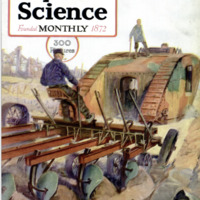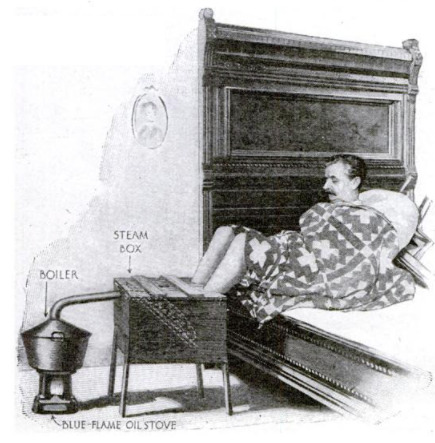The method used in French field hospitals to heal frozen hands and feet during World War I
Item
-
Title (Dublin Core)
-
The method used in French field hospitals to heal frozen hands and feet during World War I
-
Article Title and/or Image Caption (Dublin Core)
-
A Home-Made Steam Bath for Frozen Feet
-
extracted text (Extract Text)
-
THE beneficial of Joost steam bajhs an fozen
hands or feet was recognized early in the world war
by Dr. Salignat, a French physician, who used the treatment
with remarkable success in the field hospital with which he
was connected. Dr. Salignat was killed by a shell in 1916;
but the treatment originated by him has been continued
with great success.
The apparatus is extremely. simple, so that it can easily
be improvised in any field hospital. It consists of a blue-
flame kerosene stove, a boiler made of a pan with a conical
cover ending at its apex in a tube, and a steam-box of simple
construction. It has a hinged cover, and openings through
which the hands or feet are inserted into the box for treatment.
The steam enters through an opening near the top, and
escapes through small openings in the curved tube, which
is connected at its upper end with the tube from the steam-
generator and ends just below the floor of the box. The
lower opening is closed with a cork, which is removed when
it becomes necessary to allow the water of condensation to
run out. .
Wooden strips are fastened on both sides of the perforated
steam-tube to prevent the hands or feet of the patient from
coming in contact with the hot metal. Each treatment lasts
from ten minutes to fifteen minutes. At first one treatment
a day is given; later one in two or three days.
-
Language (Dublin Core)
-
eng
-
Date Issued (Dublin Core)
-
1919-02
-
pages (Bibliographic Ontology)
-
35
-
Rights (Dublin Core)
-
Public domain (Google digitized)
-
Archived by (Dublin Core)
-
Davide Donà
-
Marco Bortolami (editor)
 Popular Science Monthly, v. 94, n. 2, 1919
Popular Science Monthly, v. 94, n. 2, 1919
 Screenshot (515).png
Screenshot (515).png
